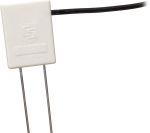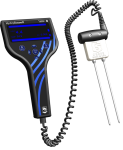This product is not available for new orders.

| Services Available |
|---|
Resumen
La CS625 mide el contenido volumétrico de agua desde el 0% hasta saturación. Es similar a la CS616 pero diseñada específicamente para los dataloggers CR200 y CR200X-series. Este reflectómetro tiene una salida en frecuencia onda cuadrada de 0 a 3.3 V que puede ser leida por nuestro datalogger CR200(X)-series.
Leer másVentajas y características
- Alta precisión
- Tiempo de respuesta rápida
- Diseñado para monitorización desatendida a largo plazo del contenido de agua
- Las varillas de la sonda se pueden insertar desde la superficie o enterrarlo en cualquier orientación.
Imágenes

Descripción detallada
The CS625 consists of two 30-cm-long stainless steel rods connected to a printed circuit board. The circuit board is encapsulated in epoxy, and a shielded four-conductor cable is connected to the circuit board to supply power, enable probe, and monitor the output.
The CS625 measures the volumetric water content of porous media (such as soil) using the time-domain measurement method; a reflectometer (cable tester) such as the TDR100 is not required. This method consists of the CS625 generating an electromagnetic pulse. The elapsed travel time and pulse reflection are then measured and used to calculate soil volumetric water content.
Response Characteristics
The signal propagating along the parallel rods of the CS625 is attenuated by free ions in the soil solution and conductive constituents of the soil mineral fraction. In most applications, the attenuation is not enough to affect the CS625 response to changing water content, and the response is well described by the standard calibration. However, in soil with relatively high soil electrical conductivity levels, compacted soils, or soils with high clay content, the calibration should be adjusted for the specific medium. Guidance for making these adjustments is provided in the operating manual.
Preguntas frecuentes
Número de FAQs relacionadas con CS625: 29
Expandir todoDesplegar todo
-
Yes, as long as the data logger can detect a 0 to 3300 mV square wave over a frequency range of 29 to 67 kHz.
-
If a soil-specific calibration is performed, the CS616/CS625 may be used in soil with a maximum bulk electrical conductivity of 5 dS/m.
-
If the electrical conductivity within the waste is less than 5 dS/m and there is good contact between the probe rods and the waste, the CS616/CS625 should respond predictably to changes in water content. The heterogeneous nature and changing bulk density of solid waste, however, make calibration difficult.
-
No. The output is too fast to be measured on the pulse channel of a 21X or CR7.
-
Yes. The rugged design of the CS616/CS625 protects the probe electronics from water under these conditions. Many CS616/CS625 reflectometers have been working reliably in very wet conditions for more than ten years.
-
The CS616/CS625 will survive frozen soil conditions, but the principle behind using bulk soil dielectric permittivity to estimate water content requires that the water be in liquid form. When soil water freezes, its dielectric drops from approximately 80 to 4, making it indistinguishable from soil solids. Consequently, the CS616/CS625 is not able to measure the water content of frozen soil.
-
Some customers have tried to use the CS616 or CS625 to measure the moisture content within a tree, but the calibration proved to be problematic. Campbell Scientific cannot provide any specific guidance for this application.
-
Yes. For program examples and guidance on using a multiplexer with one of these reflectometers, see the CS616 and CS625 instruction manual.
-
Campbell Scientific does not recommend splicing sensor cables. Sensors may be ordered with custom cable lengths, and Campbell Scientific recommends purchasing the correct length for the application. If the sensor cable needs to be lengthened, a junction box (if practical) is a more favorable option than a splice.
Note: A splice will void the sensor warranty, but a junction box does not modify the sensor and therefore does not void the warranty.
-
No. Although the CS616/CS625 could be calibrated to convert its period reading to the dielectric permittivity of snow, there is not an easy way to relate the permittivity to liquid water content. This is because the density of snow changes over time and the amount of liquid water that can be held in the solid matrix is relatively small. Additionally, the sensor emits infrared radiation that melts snow away from its rods, similar to the way snow melts around the base of a tree.
The CS616 and CS625 are not appropriate sensors for this application because of the lack of good contact between the rods and the snow, as well as the dynamic nature of the solid matrix.
Compatibilidad
Nota: lo siguiente muestra información de compatibilidad notable. No es una lista de todos los productos compatibles.
Dataloggers
| Producto | Compatible | Nota |
|---|---|---|
| CR1000 (retired) | ||
| CR200X (retired) | ||
| CR216X (retired) | ||
| CR300 (retired) | ||
| CR3000 (retired) | ||
| CR310 | ||
| CR5000 (retired) | ||
| CR800 (retired) | ||
| CR850 (retired) | ||
| CR9000X (retired) |
Información de compatibilidad adicional
RF Considerations
The RF emissions are below FCC and EU limits as specified in EN61326 if the CS625 is enabled less than 0.6 ms, and measurements are made less frequently than once a second. External RF sources can also affect the CS625 operation. Consequently, the CS625 should be located away from significant sources of RF such as ac power lines and motors.
Installation Tool
The CS650G makes inserting soil-water sensors easier in dense or rocky soils. This tool can be hammered into the soil with force that might damage the sensor if the CS650G were not used. It makes pilot holes into which the rods of the sensors can then be inserted. It replaces both the 14383 and 14384.
Data Logger Considerations
Each CS625 requires a single-ended input channel. A control port is used to enable one or more probes.
Note: A maximum of four CS625 probes can be measured by one CR200(X) datalogger. Valid channel options are analog channels 1 through 4.
Especificaciones
| Measurements Made | Volumetric water content of porous media (such as soil) |
| Water Content Accuracy | ±2.5% VWC (using standard calibration with bulk EC of ≤ 0.5 dS m-1, bulk density of ≤ 1.55 g cm-3, and measurement range of 0% to 50% VWC) |
| Required Equipment | Measurement system |
| Soil Suitability | Long rods and lower frequency are well-suited for soft soil with low electrical conductivity (< 2 dS/m). |
| Rods | Not replaceable |
| Sensors | Not interchangeable |
| Rango temperatura funcionamiento | 0° to 70°C |
| Probe-to-Probe Variability | ±0.5% VWC in dry soil, ±1.5% VWC in typical saturated soil |
| Precision | 0.1% VWC |
| Resolución | 0.1% VWC |
| Output | 0 to 3.3 V square wave (with frequency dependent on water content) |
| Current Drain |
|
| Power Supply Voltage | 5 Vdc minimum; 18 Vdc maximum |
| Enable Voltage | 4 Vdc minimum; 18 Vdc maximum |
| Electromagnetic | CE compliant (Meets EN61326 requirements for protection against electrostatic discharge.) |
| Rod Spacing | 32 mm (1.3 in.) |
| Rod Diameter | 3.2 mm (0.13 in.) |
| Rod Length | 300 mm (11.8 in.) |
| Probe Head Dimensions | 85 x 63 x 18 mm (3.3 x 2.5 x 0.7 in.) |
| Cable Weight | 35 g per m (0.38 oz per ft) |
| Peso | 280 g (9.9 oz) without cable |



